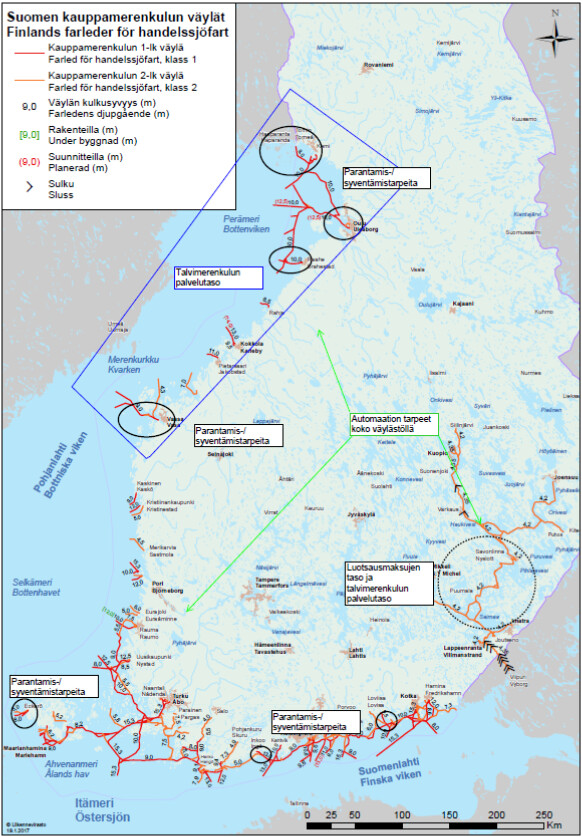This situational picture provides information about the current service level of Finland’s waterways, including a forecast of how it will develop, and related challenges. The situational picture is primarily updated once a year. The information is produced by the Finnish Transport Infrastructure Agency. The information is part of the strategic situational picture of the Finnish transport network.
This page contains a summary of various service level challenges and identified development and improvement needs in fairway maintenance and the fairway network. The issues highlighted here are based on work carried out by the Finnish Transport Infrastructure Agency.
The current service level of the fairway network primarily meets the current needs of trade and industry, which emphasise the following matters.
The needs of trade and industry have been used as a starting point for defining identified development needs in 2032 and their prioritisation.
- Ensuring the current service level of ice breaking, as the ice breaking equipment is ageing and sizes of vessels are increasing.
- The improvement and development needs of the fairways along the coast due to changes in vessel sizes and the changing needs of trade and industry.
- Enabling the development opportunities of waterborne transport on Saimaa by managing the level of pilotage dues and the functionality of winter navigation.
- Observing the new needs brought on by increasing automation aboard vessels throughout the shipping lane network.

Key changes behind the strategic situational picture
Changes affecting the strategic situational picture are primarily in the forestry sector. The changes that have happened in and are being planned for the operation of production facilities may mostly affect the freight amounts in the sea routes in Ajos in Kemi and Oulu. In addition to these changes, Russia has announced that it will be discontinuing timber transports through the Saimaa Canal. These transports amounted to almost 500,000 tonnes in total in 2020.
Forecast and challenges
Securing the service level of winter navigation on the most important fairways requires the modernisation of the current equipment. Ensuring that the service level meets the needs of shipping and waterborne transport requires a decision on acquiring new ice breaking equipment.
Implementing the necessary development projects is essential in terms of the competitiveness of trade and industry, to avoid the forming of significant bottlenecks in the fairway network. Changes that are going to occur or have occurred in the forestry sector do not have a major impact on these needs.
There have been efforts to secure the competitiveness of inland navigation through developing the Saimaa Canal. The reasonable level of pilotage dues and the functioning of ice breaking must be secured. The discontinuation of the Russian timber transports through the Saimaa Canal will not have a significant impact on the need to extend the canal locks, because the Russian network of canals restricts the size of the vessels used for these transports below the vessel size used in the canal expansion, meaning that they would not have greatly benefitted from the expansion. If the transports run through maritime ports in eastern Finland going forward, this will significantly increase the timber transports through these ports, but the impact on the overall traffic volume of the ports is minor.
The most important improvement projects should be implemented so that no considerable bottlenecks form in the fairway network and the maintenance backlog is systematically kept under control. Investments into increasing automation in traffic in accordance with shipping and waterborne transport should be made in the most important shipping lanes.